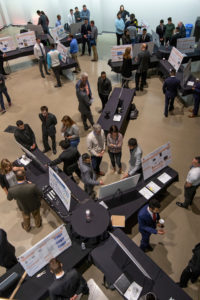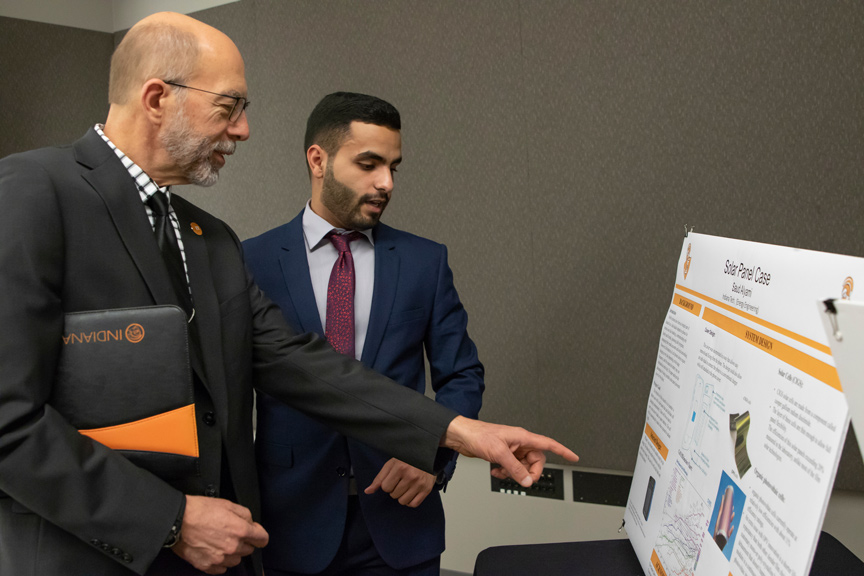Indiana Tech introduces new engineering degree program
Indiana Tech has introduced a new, online associate of science degree program in electrical engineering technology. The new program will prepare students for a wide range of technical careers, while providing employers with exceptionally qualified, highly sought staff for key positions in advanced manufacturing, engineering, electrical, computer systems, electronic and related operations.
The new Indiana Tech electrical engineering technology program will be the first of its kind in the region offered fully online. This will greatly expand access to the program and the career paths students can pursue with the degree. Students in the program will take classes online and perform lab work at home utilizing sophisticated electronics lab kits. Indiana Tech will also hold regular, optional in-person immersion events on its main campus in Fort Wayne, providing students with additional access to hands-on learning, team project work, career services and networking opportunities.
Graduates of the electrical engineering technology program will be prepared to build, test, install, operate, service and maintain all manner of electrical, manufacturing, electronic and computer systems. Areas of focus within the program include analog and digital circuitry, microprocessors, electrical machines and electronic instrumentation. Indiana Tech has also emphasized communication and collaboration within the program, including coursework that will prepare each student to be effective in verbal communication, technical writing, teamwork and leadership.
“Indiana Tech’s new electrical engineering technology program is uniquely designed to prepare students to be highly successful in technical careers,” notes Dr. Tom Kaplan, Indiana Tech’s vice president for academic affairs. “Our students will not only gain essential knowledge and skills in electrical engineering and technology, they will also learn to be effective communicators, collaborators and project leaders. Plus, by offering the program completely online, we will be able to serve many more students. Employers around Indiana and the Midwest have shared with us that they have great need for team members equipped with the skills and knowledge this program will provide.”
Current Bureau of Labor Statistics research shows that the national median salary for a technician with an associate degree in electrical engineering technology is nearly $64,000/year.
Learn more about the new Indiana Tech associate degree in electrical engineering technology here.
Partnership with Fort Financial showcases capstone projects

Indiana Tech and Fort Financial Credit Union teamed up in April to spotlight the capstone projects conceptualized by graduating seniors of the university’s College of Engineering for the first-ever Showcase of Senior Projects and Technology.
Approximately 50 senior student capstone projects were on display in the Snyder Academic Center for nearly three hours. The well-attended event was free and open to the public.
“We were pleased to give our students the opportunity to share their capstone projects with the public and to highlight the innovation taking place in Fort Wayne every day,” said dean of the College of Engineering, David Aschliman. “We thank Fort Financial for partnering with us for this event and helping us to create a platform to showcase our students.”

School of Computer Sciences senior project summaries
Below are summaries from April’s School of Computer Sciences Senior Project Day.
RaspberryTech: Chase Goodson/Emily Miller
The goal of this project is to create an affordable multimedia entertainment system using a RaspberryPi. Though the Nintendo Switch was used as an inspiration, this project will have higher usability in a more compact design. This project is a miniature computer that will allow the user to play game simulations, watch movies and create a Wi-Fi hot spot. To control the final device, custom made Bluetooth rechargeable controllers will be designed and programmed for the project.
Drive Thru Pet Food Store: Dillon Cox
This project will create a Point of Sale (POS) machine, modeled on commonly found fast food restaurants. Users will be able to order food from a menu with the push of a few buttons. Once finished, the application will calculate a total with taxes included. Final order information will be displayed for the user and written to a database. Database will store all the sales information, which will allow for daily, weekly and additional reports, based on multiple options.
Holy Cross House Client Management System: Raymond Jarvis/Jordan Owens
Holy Cross House is an assisted living company in South Bend, Indiana, and it is in need of a more customized program for client management. The solution for Holy Cross House will be a personalized, simple to use and secure program allowing for the required client management. Main features will include: a cloud-based database using ASP.NET that allows for the many different required queries and reports needed by Holy Cross House from day to day, an easy to use interface that allows for fast and easy information analysis, and a product that is cross-platform for maximum usability. This project will feature the use of ASP.NET, Python, and Bootstrap. The development process will be Agile, following a SCRUM framework.
Virtual Bartender: Logan Herald/Nic Williams
The goal of this project is to create a virtual bartender that recognizes patrons via facial recognition and determines whether they are new or returning customers. Once the customer is integrated into the system, the customer can order a drink via speech recognition. Each drink that the bartender can make has associated flavors: Sweet, Sour, Bitter, Dry, Smokey, etc. After a user orders a drink the virtual bartender will log that drink and its corresponding flavors to the user and use that knowledge to develop a specific “flavor profile” per user. This flavor profile will be used to recommend drinks that match a users flavor profile during their next order.
AnyWavesMusic Website Development (anywavesmusic.com): Todd Harmon
AnyWaves Music will be a website where users can join a large community of music enthusiasts in reading and writing a variety of music news and reviews along with expanding their music experience. The website will feature modern design along with dynamic content capabilities. Users will have the ability to create their own profiles with which to make forum posts and user reviews. These profiles will also allow them to track news and reviews made by the website editors and create lists of favorites. The website will also ultimately feature interfaces to draw in information from users’ exiting music media profiles such as Spotify and Pandora. On the server side of the website, reviews will be posted for the general public to read and enjoy along with the opinions of the user reviews. The website will feature a wide array of content from the newest and most hidden releases in music to the classics that are still popular to this day.
Jethro–GBCTK: Corey Mack
The goal of this project is to create a software development toolkit for developing software and games for the Nintendo Gameboy Color (GBC). This toolkit will help developers create software for the simple and popular 8-bit GBC. Features of the toolkit include:
- An interface with a Raspberry Pi Zero to transfer machine code onto an appropriate EEPROM intended for use on actual GBC hardware.
- A simple assembler for the GBC (optional).
- A graphics editor.
- A sound editor (optional). To demonstrate completion of the toolkit, a small demo piece of software will be created.
Network Performance Tools: Alan Roach
The purpose of this application is to develop a set of tools to measure various network performance metrics, while giving the user a high degree of interactivity. The user will be able to access bandwidth usage over cell, wireless, and possibly other connection methods. They will be able to choose points along the network to determine the link speed from their device to the selected node. Finally, they will be able to determine network latency (not unlike popular speed test tools), from a set of supplied endpoints.
Predictive Bowling App: Carlton Hart/Randall Stroshein
In bowling, it is important know what bowling ball is the best to use and which bowling balls would be a good addition to your arsenal. Currently, there is not an easy way to determine this for less experienced players without having to go to a pro shop and see a professional. The Suggestive Bowling App seeks to change that. It will allow for scores to be recorded and will use those scores to determine which ball should be used depending on the lane conditions and oil patterns. Going off of your current equipment, it will keep track of how often each ball is used and will recommend cleaning, resurfacing, and replacement with new balls. This app will also keep track of individual player statistics such as strike percentage, spare percentage, and so on. In conclusion, the Suggestive Bowling App will streamline the process of maintaining and obtaining new bowling balls.
Deepfakes and AI: Aaron Stauffer
Deepfakes are pictures and/or videos made by swapping one persons face with another persons face with artificial-intelligence (AI). The word Deepfakes comes from an AI doing something called deep learning to make a fake picture, video, or audio recording.
Global Store Website: Tariq Alwardi/Abdullah Alrusaymi
The project’s goal is to connect all superstores, like Walmart, Kroger and others, so customers can buy groceries and other products online from home and have them delivered to their home.
Raspberry PI Network Intrusion Detection: Rayan Alazmi
Network Intrusion detection system in Raspberry pi3 model B is basically monitors all traffic outbound and inbound from all devices that connect to the internet. It will capture and analyzes network packets to detect network anomalies to be analyzed at the same time or lagged and analyzed at a later time.
IOS Bowling Practice App: Tyler Hoppe
This IOS app will be used to log bowling practice sessions. Practice sessions have five options available.
Operating System Vulnerabilities: Lena Allafi
This project shows a possible vulnerability that any hacker could use to copy the files you have on your device, such as pictures, video, and music, into the flash drive silently without asking for your permission.
Location Analytics: Zack Meredith
Location Analytics is the process or ability to gain insight from a location or geographic component of business data. Location Analytics is used as a way to find which building would be the best place to keep computer backup data on campus.
